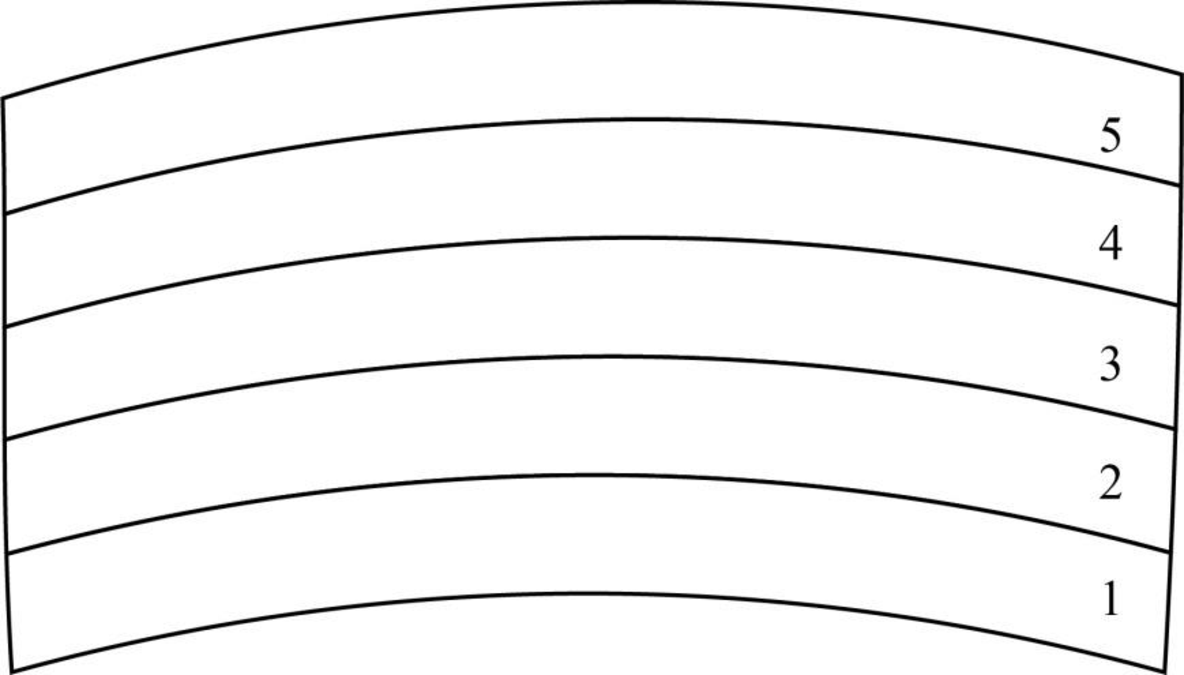
The cross-sectional sequence of different layers of sedimentary rocks depicting the laws of original continuity, superposition, and original horizontality.
Answer to Problem 1QR
The characteristics features, formation and composition of sedimentary rock can be explained through the law of original continuity, the law of superposition, and the law of original horizontality.
Explanation of Solution
Pictorial representation: Fig.1 represents, the cross section of a sedimentary rock demonstrating the law of original horizontality. Fig.2 represents the corss section of a sedimentary rock demonstrating the law of superposition. Fig.3 represents the corss section of a sedimentary rock demonstrating the law of original continuity.

Fig. 1: Cross section of a sedimentary rock (law of original horizontality)

Fig. 2: Cross section of a sedimentary rock (law of superposition)

Fig. 3: Cross section of sedimentary rock (law of original continuity).
(i) Law of original horizontality: This law describes the formation of sedimentary rock and involves the sequential deposition of sediments in a horizontal layer. Fig.1 shows a sedimentary rock formed by five layers of sedimentation. The layer 1 represents the oldest sedimentation layer while layer 5 depicts the newest sedimentation layer. Based on the law of original horizontality, it can be ascertained that the deformed layer shown above have been originally formed due to horizontal sedimentation.
(ii) Law of superposition: This law describes that in case the sedimentary rock has not undergone deformation, the sedimentation layers are arranged such that the youngest layer is the topmost while the oldest layer is formed by the bottom sedimentation layers. Fig.2 describes the sedimentary layer arrangement in sedimentary rock. This figure shows five layers in a non-deformed sedimentary rock. The layer 1 (bottom) corresponds to the oldest sedimentation layer while layer 5 (top) depicts the youngest layer.
(iii) Law of original continuity: This law states that the layers of sedimentary rock are continuous only when the sedimentary rock demonstrates a gradual change between successive sedimentation layers. In case a discontinuity is observed in the sedimentary layers, it is primarily due to fault movements. Fig.3 represents a sedimentary rock having five layers. The deformation ranging from layer 2 to layer 5 can be attributed to fault movements.
Want to see more full solutions like this?
Chapter 3 Solutions
NATURAL DISASTERS(LL) W/CONNECT
 Applications and Investigations in Earth Science ...Earth ScienceISBN:9780134746241Author:Edward J. Tarbuck, Frederick K. Lutgens, Dennis G. TasaPublisher:PEARSON
Applications and Investigations in Earth Science ...Earth ScienceISBN:9780134746241Author:Edward J. Tarbuck, Frederick K. Lutgens, Dennis G. TasaPublisher:PEARSON Exercises for Weather & Climate (9th Edition)Earth ScienceISBN:9780134041360Author:Greg CarbonePublisher:PEARSON
Exercises for Weather & Climate (9th Edition)Earth ScienceISBN:9780134041360Author:Greg CarbonePublisher:PEARSON Environmental ScienceEarth ScienceISBN:9781260153125Author:William P Cunningham Prof., Mary Ann Cunningham ProfessorPublisher:McGraw-Hill Education
Environmental ScienceEarth ScienceISBN:9781260153125Author:William P Cunningham Prof., Mary Ann Cunningham ProfessorPublisher:McGraw-Hill Education Earth Science (15th Edition)Earth ScienceISBN:9780134543536Author:Edward J. Tarbuck, Frederick K. Lutgens, Dennis G. TasaPublisher:PEARSON
Earth Science (15th Edition)Earth ScienceISBN:9780134543536Author:Edward J. Tarbuck, Frederick K. Lutgens, Dennis G. TasaPublisher:PEARSON Environmental Science (MindTap Course List)Earth ScienceISBN:9781337569613Author:G. Tyler Miller, Scott SpoolmanPublisher:Cengage Learning
Environmental Science (MindTap Course List)Earth ScienceISBN:9781337569613Author:G. Tyler Miller, Scott SpoolmanPublisher:Cengage Learning Physical GeologyEarth ScienceISBN:9781259916823Author:Plummer, Charles C., CARLSON, Diane H., Hammersley, LisaPublisher:Mcgraw-hill Education,
Physical GeologyEarth ScienceISBN:9781259916823Author:Plummer, Charles C., CARLSON, Diane H., Hammersley, LisaPublisher:Mcgraw-hill Education,





